I'm trying to reproduce a scenario like this where the red and blue rectangles can occupy same width and height (and same gap between them) for different screen sizes.
I'm using NSLayoutConstraint (I know that anchors are preferred now, just trying to explore the basics). I tried the following code in swift playground:
import Foundation
import UIKit
import PlaygroundSupport
class MyViewController : UIViewController {
var firstColorView: UIView!
var secondColorView: UIView!
override func viewWillAppear(_ animated: Bool) {
var myView: UIView!
myView = view
myView.backgroundColor = .white
firstColorView = UIView()
secondColorView = UIView()
firstColorView.backgroundColor = .red
secondColorView.backgroundColor = .blue
myView.addSubview(firstColorView)
myView.addSubview(secondColorView)
//myView.translatesAutoresizingMaskIntoConstraints = false
//view.addSubview(myView)
// horizontal constraints
let left_constraint = NSLayoutConstraint(item: firstColorView, attribute: .leftMargin, relatedBy: .equal, toItem: myView, attribute: .left, multiplier: 1.0, constant: 20)
let middle_constraint = NSLayoutConstraint(item: secondColorView, attribute: .leftMargin, relatedBy: .equal, toItem: firstColorView, attribute: .right, multiplier: 1.0, constant: 10)
let right_constraint = NSLayoutConstraint(item: myView, attribute: .rightMargin, relatedBy: .equal, toItem: secondColorView, attribute: .right, multiplier: 1.0, constant: 20)
let width_constraint = NSLayoutConstraint(item: firstColorView, attribute: .width, relatedBy: .equal, toItem: secondColorView, attribute: .width, multiplier: 1.0, constant: 0)
// vertical constraints
let top_constraint1 = NSLayoutConstraint(item: firstColorView, attribute: .top, relatedBy: .equal, toItem: myView, attribute: .top, multiplier: 1.0, constant: 10)
let top_constraint2 = NSLayoutConstraint(item: secondColorView, attribute: .top, relatedBy: .equal, toItem: myView, attribute: .top, multiplier: 1.0, constant: 10)
let bottom_constraint1 = NSLayoutConstraint(item: myView, attribute: .bottom, relatedBy: .equal, toItem: firstColorView, attribute: .bottom, multiplier: 1.0, constant: 10)
let bottom_constraint2 = NSLayoutConstraint(item: myView, attribute: .bottom, relatedBy: .equal, toItem: secondColorView, attribute: .bottom, multiplier: 1.0, constant: 0)
NSLayoutConstraint.activate([left_constraint, middle_constraint, right_constraint, width_constraint, top_constraint1, top_constraint2, bottom_constraint1, bottom_constraint2])
self.view.layoutIfNeeded()
}
}
// Present the view controller in the Live View window
PlaygroundPage.current.needsIndefiniteExecution = true
PlaygroundPage.current.liveView = MyViewController()
But all it shows is a white screen, whose width doesn't match an iphone's. What am I doing wrong here? Why can't I see the red and blue screen?
